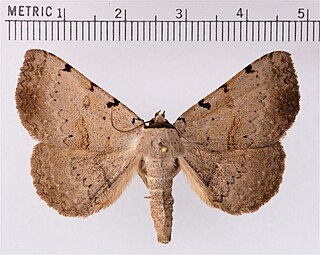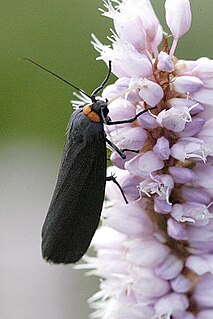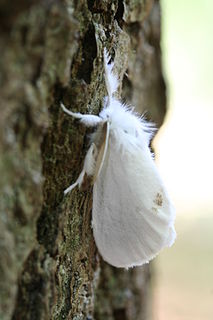
The Arctiinae are a large and diverse subfamily of moths with around 11,000 species found all over the world, including 6,000 neotropical species. This subfamily includes the groups commonly known as tiger moths which usually have bright colours, footmen which are usually much drabber, lichen moths, and wasp moths. Many species have "hairy" caterpillars that are popularly known as woolly bears or woolly worms. The scientific name Arctiinae refers to this hairiness. Some species within the Arctiinae have the word tussock in their common name because they have been misidentified as members of the Lymantriinae subfamily based on the characteristics of the larvae.

The Catocalini are a tribe of moths in the family Erebidae. Adults of many species in the tribe are called underwing moths due to their vividly colored hindwings that are often covered by contrastingly dark, drab forewings.

The Calpinae are a subfamily of moths in the family Erebidae described by Jean Baptiste Boisduval in 1840. This subfamily includes many species of moths that have a pointed and barbed proboscis adapted to piercing the skins of fruit to feed on juice, and in the case of the several Calyptra species of vampire moths, to piercing the skins of mammals to feed on blood. The subfamily contains some large moths with wingspans longer than 5 cm (2 in).

The Ctenuchina are a subtribe of moths in the family Erebidae.

The Lithosiini are a tribe of lichen moths in the family Erebidae. The taxon was described by Gustaf Johan Billberg in 1820.
Hypenagonia is a genus of moths of the family Erebidae first described by George Hampson in 1893. The adult moths have pale brown wings with a dark band across each wing. The wingspan of these moths is about 1 centimeter.

The Erebidae are a family of moths in the superfamily Noctuoidea. The family is among the largest families of moths by species count and contains a wide variety of well-known macromoth groups. The family includes the underwings (Catocala); litter moths (Herminiinae); tiger, lichen, and wasp moths (Arctiinae); tussock moths (Lymantriinae), including the arctic woolly bear moth ; piercing moths ; micronoctuoid moths (Micronoctuini); snout moths (Hypeninae); and zales, though many of these common names can also refer to moths outside the Erebidae. Some of the erebid moths are called owlets.

The Erebinae are a subfamily of moths in the family Erebidae erected by William Elford Leach in 1815. Erebine moths are found on all continents except Antarctica, but reach their greatest diversity in the tropics. While the exact number of species belonging to the Erebinae is not known, the subfamily is estimated to include around 10,000 species. Some well-known Erebinae include underwing moths (Catocala) and witch moths (Thermesiini). Many of the species in the subfamily have medium to large wingspans, up to nearly 30 cm in the white witch moth, which has the widest wingspan of all Lepidoptera. Erebine caterpillars feed on a broad range of plants; many species feed on grasses and legumes, and a few are pests of castor bean, sugarcane, rice, as well as pistachios and blackberries.
The Micronoctuini are a tribe of moths in the family Erebidae that includes about 400 described species. Typical species in the tribe have bifine hindwing venation and are smaller than those in other noctuoid moths. Micronoctua karsholti is the smallest of all species in the superfamily Noctuoidea.

Lymantriini is a tribe of moths of the family Erebidae. This tribe is a group of polyphagous moths that reside mostly in the tropical regions of Afro-Eurasia but also North America.
The Pericymini are a tribe of moths in the family Erebidae.
The Pandesmini are a tribe of moths in the family Erebidae.

The Orgyiini are a tribe of tussock moths of the family Erebidae. The tribe was described by Wallengren in 1861.

The Nygmiini are a tribe of tussock moths of the Erebidae family.

The Leucomini are a tribe of tussock moths of the family Erebidae.

The Cocytiini are a tribe of moths in the family Erebidae. Adults of some members of the subfamily, especially in the genus Serrodes, have a proboscis capable of piercing fruit skins, allowing the moth to drink the fruit juice.
The Hulodini are a tribe of moths in the family Erebidae.

The Hypopyrini are a tribe of moths in the family Erebidae.

The Ommatophorini are a tribe of moths in the family Erebidae.

The Sypnini are a tribe of moths in the family Erebidae.














